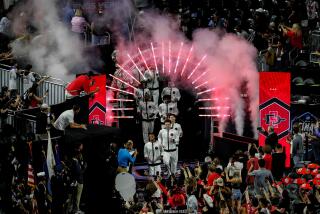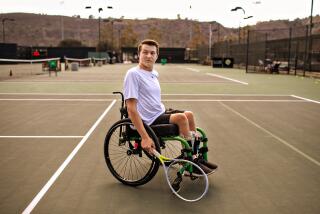COURT ORDER : Neither Patridge nor Stewart Is Willing to Surrender the No. 1 Position at USD
- Share via
SAN DIEGO — Maybe the best way to introduce the top two players on the University of San Diego’s men’s tennis team is in alphabetical order.
Now, if only the rules said they could play matches in this order, too.
Meet, first, Scott Patridge, a 6-foot senior who hits the ball with authority, flashes a wide grin at everybody he meets, and who, according to his coach, Ed Collins, talks with authority, too.
“He should go on and become a car salesman,” was the way Collins put it. “You ask him something, he’ll tell you everything you need to know . . . and then some.”
He’ll also tell you that ever since he grew up in Saratoga near San Jose and started playing at the Brookside Racquet Club, he has wanted to be a tennis star.
He has been at USD for five years, and he has always been driven by the thought of becoming No. 1.
In order to reach that goal this year, however, he has had to compete against:
David Stewart, a 5-10, 150-pound junior, who has never hit the ball too hard in his life, smiles on the inside when one of his placement shots lands just out of your reach, and who, according to his coach probably would not make much of a car salesman.
“Oh, yeah, David is much quieter,” Collins said.
“David has always put tennis No. 1 in his life,” said Mark Ferran, Stewart’s roommate, teammate and friend since the two grew up together in Saratoga--the same one near San Jose--and played tennis at the Brookside Racquet Club.
“The thing is that for the longest time, he didn’t have a No. 2 or No. 3. Now tennis is still most important to him, but there are other things as well.”
Tennis is still No. 1. And Stewart wants to be No. 1. He has been at USD for three years, and he has strived for it.
Patridge has strived for it, too. Both he and Stewart are driven by the desire to have the honor.
“There’s been some problems,” said Curtis Dadian, one of the Toreros’ best doubles players. “I mean, neither of them seems too satisfied when they’re playing No. 2, and it’s hurt our team some.”
Still, there have been no fistfights, no verbal confrontations, and no name-calling.
In fact, it’s quite the opposite. And here’s why:
The No. 1 doubles team at USD is the team of--let’s stick with alphabetical order--Scott Patridge and David Stewart.
“When we play doubles together (they’re 12-8), we’re able to forget about everything,” Stewart said. “It’s weird, but we can do it.”
The battle for No. 1, however, has raged on. And both players have gone through some struggling times.
“A lot of people might think that it would be a coach’s dream to have two players who are No. 1s,” Collins said. “But it hasn’t been easy. And the simple fact is, the two players have combined for a better record when they’ve played No. 1 (15-11) than they have when they’ve played No. 2 (10-11).”
The two have been sharing the No. 1 position for the last month now. Before that, Stewart held down the top spot.
Like a lot of other youngsters, Stewart grew up with a racket in his hand and a lot of desire in his heart.
He learned to wear down his opponents on the baseline, taking advantage of his quickness and touch and covering up for his lack of size and strength.
He hardly ever served and volleyed because he hardly ever had to. He was the best player for his age at the Brookside Club, and winning was all that was important.
“Looking back, I wish I hadn’t been told about winning so much,” Stewart said. “It was always, ‘Win, win, win.’ It would have been better if I had learned to serve and volley.”
Nowadays, he comes to the net more, but when the going gets tough, chances are he’ll stay back. He’s toughest and most comfortable there.
Late in November, as a matter of fact, Stewart was playing brilliantly from there. And everywhere else, too.
Collins had thought about going with Patridge at No. 1, but Stewart was playing too well.
Collins decided on a friendly little battle for No. 1. Two days before the season, he told Patridge and Stewart that they would play for the No. 1 position.
One day before the season opened, the two played.
Patridge and Stewart had been friends growing up at the Brookside Club and had even played against each other. But Patridge, 22, and Stewart, 20, hardly ever played in the same competitions because they were in different age categories.
This would be quite a showdown.
“It was the most nervous I ever was for a match in my life,” Patridge said. “I had worked all my career to be No. 1, and now I could lose it all on one match.”
He did lose it. Stewart won, 7-6, 6-4. And, admittedly, Patridge didn’t handle it well.
He had grown up in the same area as Stewart, but maybe not as much of a structured setting. Stewart went to a private high school, Bellarmine Prep, and Patridge went to a public school, Saratoga High.
Patridge was not driven by a win-win-win attitude, and though he was a good player when he was young, he didn’t succeed as much as Stewart did.
Patridge had always been more of a happy-go-lucky character, but early this season, the fun stopped. He was No. 2 and miserable.
“I would be playing a match on the court next to David’s and would be more worried about how he was doing,” Patridge said. “I wanted to win my match before he won his, so it would look more convincing.
“If I was struggling in the second set and I saw him win, it was a big downer for me.”
In one match against Nebraska, Stewart won, and Patridge was down a set and a break. Right then, however, something clicked. Patridge had a little chat with himself while standing on the baseline and turned his season around.
“I knew right then that I didn’t want to go through what I was going through anymore,” he said. “I had been rebelling against myself. I decided my tennis career was too important, and I knew I had to stop worrying and just play the best I could play.”
Patridge rallied to win and then won his next nine matches. All of a sudden the battle for No. 1 was on again.
Collins, in trying to reward his hottest player, moved Patridge up and dropped Stewart down. Patridge played better, and Stewart slumped.
Funny how it seems both players only struggled while playing No. 2.
“There’s actually a simple explanation,” Collins said. “When you lose a match at No. 2, it costs you more in your individual rankings. So sometimes the pressure is greater at No. 2. Both players want to make the NCAA tournament and of course would like to help us make it as a team, but those losses can hurt you.”
Right now, Patridge and Stewart appear headed for the postseason individual tournament. Although USD (15-11) has been ranked as high as No. 24 in the country during parts of the season, it probably will come up short.
“That would be the ultimate for both of us to get there,” Patridge said. “Because even though we’ve competed against each other, we like each other as players and friends.
“If we made it, though, I’d like to be in different brackets. I don’t know if I could stand the pressure of having to play him again.”
More to Read
Get our high school sports newsletter
Prep Rally is devoted to the SoCal high school sports experience, bringing you scores, stories and a behind-the-scenes look at what makes prep sports so popular.
You may occasionally receive promotional content from the Los Angeles Times.






